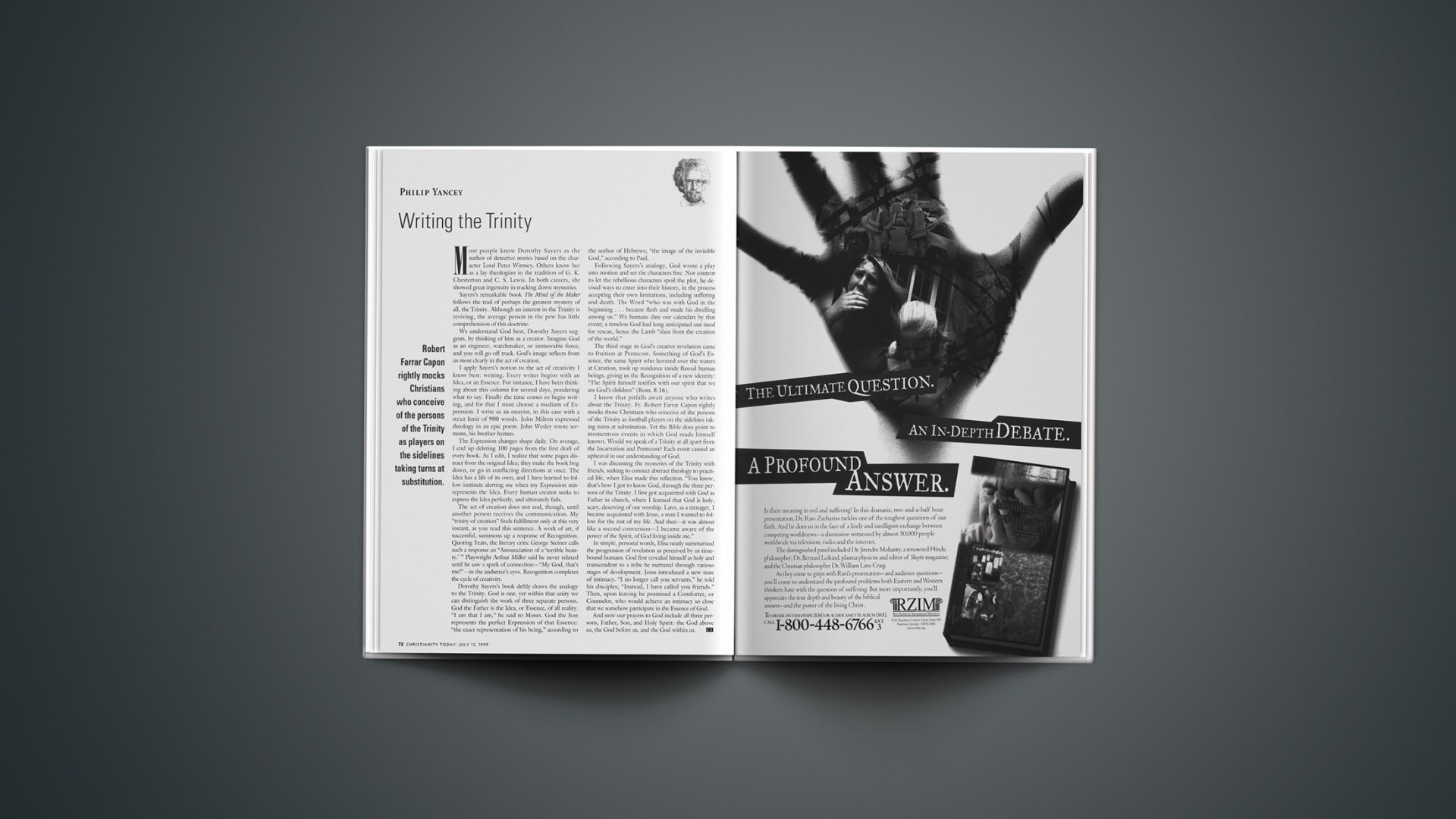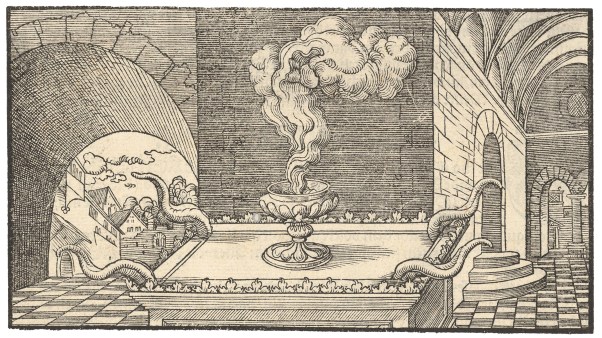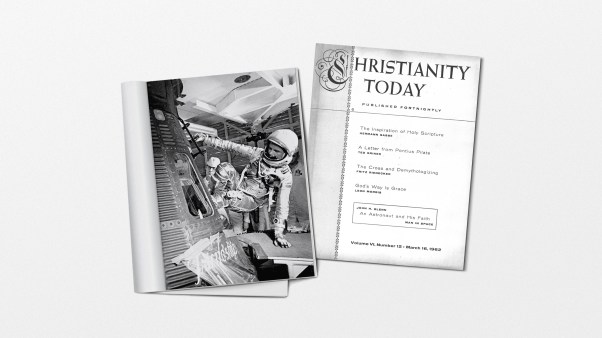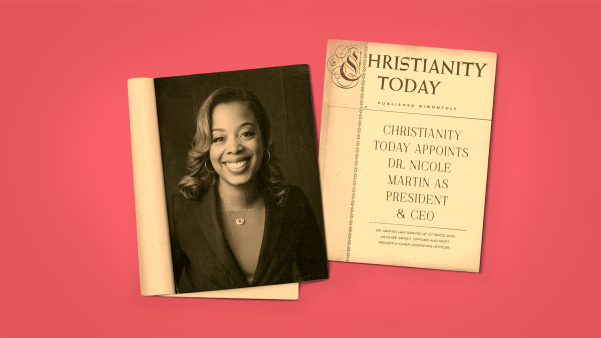Most people know Dorothy Sayers as the author of detective stories based on the character Lord Peter Wimsey. Others know her as a lay theologian in the tradition of G. K. Chesterton and C. S. Lewis. In both careers, she showed great ingenuity in tracking down mysteries.
Sayers’s remarkable book The Mind of the Maker follows the trail of perhaps the greatest mystery of all, the Trinity. Although an interest in the Trinity is reviving, the average person in the pew has little comprehension of this doctrine.
We understand God best, Dorothy Sayers suggests, by thinking of him as a creator. Imagine God as an engineer, watchmaker, or immovable force, and you will go off track. God’s image reflects from us most clearly in the act of creation.
I apply Sayers’s notion to the act of creativity I know best: writing. Every writer begins with an Idea, or an Essence. For instance, I have been thinking about this column for several days, pondering what to say. Finally the time comes to begin writing, and for that I must choose a medium of Expression. I write as an essayist, in this case with a strict limit of 900 words. John Milton expressed theology in an epic poem. John Wesley wrote sermons, his brother hymns.
The Expression changes shape daily. On average, I end up deleting 100 pages from the first draft of every book. As I edit, I realize that some pages distract from the original Idea; they make the book bog down, or go in conflicting directions at once. The Idea has a life of its own, and I have learned to follow instincts alerting me when my Expression misrepresents the Idea. Every human creator seeks to express the Idea perfectly, and ultimately fails.
The act of creation does not end, though, until another person receives the communication. My “trinity of creation” finds fulfillment only at this very instant, as you read this sentence. A work of art, if successful, summons up a response of Recognition. Quoting Yeats, the literary critic George Steiner calls such a response an “Annunciation of a ‘terrible beauty.’ ” Playwright Arthur Miller said he never relaxed until he saw a spark of connection—”My God, that’s me!”—in the audience’s eyes. Recognition completes the cycle of creativity.
Dorothy Sayers’s book deftly draws the analogy to the Trinity. God is one, yet within that unity we can distinguish the work of three separate persons. God the Father is the Idea, or Essence, of all reality. “I am that I am,” he said to Moses. God the Son represents the perfect Expression of that Essence: “the exact representation of his being,” according to the author of Hebrews; “the image of the invisible God,” according to Paul.
Following Sayers’s analogy, God wrote a play into motion and set the characters free. Not content to let the rebellious characters spoil the plot, he devised ways to enter into their history, in the process accepting their own limitations, including suffering and death. The Word “who was with God in the beginning … became flesh and made his dwelling among us.” We humans date our calendars by that event; a timeless God had long anticipated our need for rescue, hence the Lamb “slain from the creation of the world.”
The third stage in God’s creative revelation came to fruition at Pentecost. Something of God’s Essence, the same Spirit who hovered over the waters at Creation, took up residence inside flawed human beings, giving us the Recognition of a new identity: “The Spirit himself testifies with our spirit that we are God’s children” (Rom. 8:16).
I know that pitfalls await anyone who writes about the Trinity. Fr. Robert Farrar Capon rightly mocks those Christians who conceive of the persons of the Trinity as football players on the sidelines taking turns at substitution. Yet the Bible does point to momentous events in which God made himself known. Would we speak of a Trinity at all apart from the Incarnation and Pentecost? Each event caused an upheaval in our understanding of God.
I was discussing the mysteries of the Trinity with friends, seeking to connect abstract theology to practical life, when Elisa made this reflection. “You know, that’s how I got to know God, through the three persons of the Trinity. I first got acquainted with God as Father in church, where I learned that God is holy, scary, deserving of our worship. Later, as a teenager, I became acquainted with Jesus, a man I wanted to follow for the rest of my life. And then—it was almost like a second conversion—I became aware of the power of the Spirit, of God living inside me.”
In simple, personal words, Elisa neatly summarized the progression of revelation as perceived by us time-bound humans. God first revealed himself as holy and transcendent to a tribe he nurtured through various stages of development. Jesus introduced a new state of intimacy. “I no longer call you servants,” he told his disciples; “Instead, I have called you friends.” Then, upon leaving he promised a Comforter, or Counselor, who would achieve an intimacy so close that we somehow participate in the Essence of God.
And now our prayers to God include all three persons, Father, Son, and Holy Spirit: the God above us, the God before us, and the God within us.
Copyright © 1999 Christianity Today. Click for reprint information.










